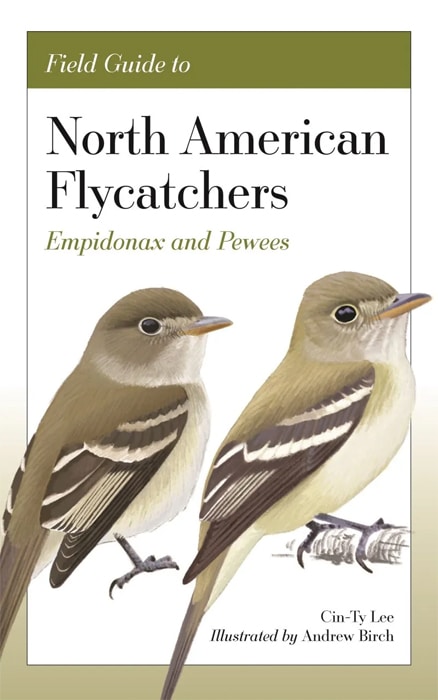| Field Guide to North American Flycatchers: Empidonax and Pewees | A Natural History of our planet’s bee life | Cin-Ty Lee & Andrew Birch | Princeton University Press | 2023 | Flexibound | 157 pages, 55 colour & b/w illustrations, 19 colour distribution maps | ISBN: 9780691240626 |

The Publisher’s View:
The identification of Empidonax flycatchers and pewees can be a daunting challenge for even the most seasoned birder. Field Guide to North American Flycatchers takes bird identification to an entirely new level by training you how to observe subtle differences in structure, colour patterns, and vocalizations before delving into the finer details of a particular species. Because the plumages of flycatchers are so similar, this one-of-a-kind guide uses illustrations that highlight slight variances among species that photos often miss. One of the last frontiers of bird identification is now accessible to everyone – once one knows what to look for.
– Uses a holistic approach that makes flycatcher identification possible even for beginners
– Features a wealth of beautiful illustrations that depict every species in North America
– Shows how to observe subtle differences in structure, plumage contrasts, and vocalizations, which together create a distinctive overall impression of the bird
– Includes detailed audio spectrograms and seasonal distribution maps for each species
– Shares invaluable tips for successful identification in all kinds of field settings
– Its compact size and field-friendly layout make it the ideal travel companion for any birder
The Authors: Cin-Ty Lee is a professor in the Department of Earth, Environmental, and Planetary Sciences at Rice University. Andrew Birch has provided illustrations for numerous bird identification articles and books.
Fatbirder View:
Here’s a confession. When seeing flycatchers in Canada, the US and Mexico I relied almost entirely on other people’s ID. Being as good at recognising song as Donald Trump is at recognising his own ignorance, that was no help. Otherwise, I made a fair stab at some, purely on the basis of distribution. The one exception has to be America’s prettiest flycatcher, and, for me the top bird I saw in the US; Scissor-tailed Flycatcher. To be fair I had stonking views as it used its tail to balance on a barbed-wire fence in a stiff breeze. The slate grey and peach plumage was beautiful.
The Kingbirds and other Flycatchers mostly stayed where they should and I relied on other’s where territory overlapped. Could I have done better had I this volume been in my hip pocket? Almost certainly. For a start, treating the whole bird as the key rather than particular features appeals to me… I think that is my intuitive method… jizz as we Brit birders call it, general impression and size whittles down the options as does song if you don’t have my tin ear.
Its packed full of detailed plumage sketches, outline shapes and, of course, a great deal more. The author’s expertise is shared methodically and with great clarity, making it very accessible. My only criticism is of the publisher’s designer who makes no concession to weak or aging eyes by using grey font under the illustrations. If they had stuck with black and italicised them instead it would suit more readers. The book is meant to be read and used, not admired for its artistry, let alone the designers stamp. Design is first about function, which should never be compromised for aesthetics!
The book will sit on many a banding room shelf in North America, but would also be a wise addition to ringing sheds in the UK in case some ‘yankee’ flycatcher gets swept over the pond by the ever-increasing westerly storms of Autumn.
Fatbirder
